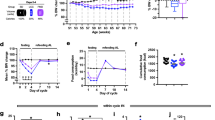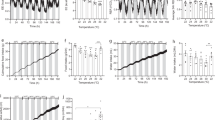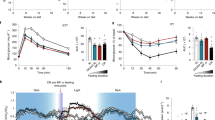Abstract
Background:
Excess caloric intake is strongly associated with the development of increased adiposity, glucose intolerance, insulin resistance, dyslipidemia, and hyperleptinemia (that is the cardiometabolic syndrome). Research efforts have focused attention primarily on the quality (that is nutritional content) and/or quantity of ingested calories as potential causes for diet-induced pathology. Despite growing acceptance that biological rhythms profoundly influence energy homeostasis, little is known regarding how the timing of nutrient ingestion influences development of common metabolic diseases.
Objective:
To test the hypothesis that the time of day at which dietary fat is consumed significantly influences multiple cardiometabolic syndrome parameters.
Results:
We report that mice fed either low- or high-fat diets in a contiguous manner during the 12 h awake/active period adjust both food intake and energy expenditure appropriately, such that metabolic parameters are maintained within a normal physiologic range. In contrast, fluctuation in dietary composition during the active period (as occurs in human beings) markedly influences whole body metabolic homeostasis. Mice fed a high-fat meal at the beginning of the active period retain metabolic flexibility in response to dietary challenges later in the active period (as revealed by indirect calorimetry). Conversely, consumption of high-fat meal at the end of the active phase leads to increased weight gain, adiposity, glucose intolerance, hyperinsulinemia, hypertriglyceridemia, and hyperleptinemia (that is cardiometabolic syndrome) in mice. The latter perturbations in energy/metabolic homeostasis are independent of daily total or fat-derived calories.
Conclusions:
The time of day at which carbohydrate versus fat is consumed markedly influences multiple cardiometabolic syndrome parameters.
This is a preview of subscription content, access via your institution
Access options
Subscribe to this journal
Receive 12 print issues and online access
$259.00 per year
only $21.58 per issue
Buy this article
- Purchase on Springer Link
- Instant access to full article PDF
Prices may be subject to local taxes which are calculated during checkout






Similar content being viewed by others
References
Harma M, Ilmarinen J . Towards the 24-h society—new approaches for aging shift workers? Scand J Work Envion Health 1999; 25: 610–615.
Knutsson A, Akerstedt T, Jonsson B, Orth-Gomer K . Increased risk of ischaemic heart disease in shift workers. Lancet 1986; 12: 89–92.
Knutson KL, Spiegel K, Penev P, Van Cauter E . The metabolic consequences of sleep deprivation. Sleep Med Rev 2007; 11: 163–178.
de Castro JM . The time of day of food intake influences overall intake in humans. J Nutr 2004; 134: 104–111.
de Castro JM . The time of day and the proportions of macronutrients eaten are related to total daily food intake. Br J Nutr 2007; 98: 1077–1083.
Arble DM, Bass J, Laposky AD, Vitaterna MH, Turek FW . Circadian timing of food intake contributes to weight gain. Obesity (Silver Spring) 2009; 17: 2100–2102.
Schibler U, Ripperger J, Brown S . Peripheral circadian oscillations in mammals: time and food. J Biol Rhythms 2003; 18: 250–260.
Tsai JY, Kienesberger PC, Pulinilkunnil T, Sailors MH, Durgan DJ, Villegas-Montoya C et al. Direct regulation of myocardial triglyceride metabolism by the cardiomyocyte circadian clock. J Biol Chem 2010; 285: 2918–2929.
Frederich RC, Hamann A, Anderson S, Lollmann B, Lowell BB, Flier JS . Leptin levels reflect body lipid content in mice: evidence for diet-induced resistance to leptin action. Nat Med 1995; 1: 1311–1314.
Martin TL, Alquier T, Asakura K, Furukawa N, Preitner F, Kahn BB . Diet-induced obesity alters AMP kinase activity in hypothalamus and skeletal muscle. J Biol Chem 2006; 281: 18933–18941.
Giovannini M, Verduci E, Scaglioni S, Salvatici E, Bonza M, Riva E et al. Breakfast: a good habit, not a repetitive custom. J Int Med Res 2008; 36: 613–624.
Cho S, Dietrich M, Brown CJ, Clark CA, Block G . The effect of breakfast type on total daily energy intake and body mass index: results from the Third National Health and Nutrition Examination Survey (NHANES III). J Am Coll Nutr 2003; 22: 296–302.
Warren JM, Henry CJ, Simonite V . Low glycemic index breakfasts and reduced food intake in preadolescent children. Pediatrics 2003; 112: e414.
Stunkard AJ, Allison KC, Lundgren JD, O’Reardon JP . A biobehavioural model of the night eating syndrome. Obes Rev 2009; 10 (Suppl 2): 69–77.
Li S, Lin JD . Molecular control of circadian metabolic rhythms. J Appl Physiol 2009; 107: 1959–1964.
Eckel-Mahan K, Sassone-Corsi P . Metabolism control by the circadian clock and vice versa. Nat Struct Mol Biol 2009; 16: 462–467.
Edery I . Circadian rhythms in a nutshell. Physiol Genomics 2000; 3: 59–74.
Marcheva B, Ramsey KM, Affinati A, Bass J . Clock genes and metabolic disease. J Appl Physiol 2009; 107: 1638–1646.
Turek F, Joshu C, Kohsaka A, Lin E, Ivanova G, McDearmon E et al. Obesity and metabolic syndrome in clock mutant mice. Science 2005; 308: 1043–1045.
Bunger MK, Walisser JA, Sullivan R, Manley PA, Moran SM, Kalscheur VL et al. Progressive arthropathy in mice with a targeted disruption of the Mop3/Bmal-1 locus. Genesis 2005; 41: 122–132.
Shimba S, Ishii N, Ohta Y, Ohno T, Watabe Y, Hayashi M et al. Brain and muscle Arnt-like protein-1 (BMAL1), a component of the molecular clock, regulates adipogenesis. Proc Natl Acad Sci USA 2005; 102: 12071–12076.
Acknowledgements
This work was supported by Kraft Foods Inc., the USDA/ARS (6250–51000–046 and 6250–51000–044), and the National Heart, Lung, and Blood Institute (HL-074259). Ju-Yun Tsai was supported by the DeBakey Heart Fund at Baylor College of Medicine.
Author information
Authors and Affiliations
Corresponding author
Ethics declarations
Competing interests
The authors declare no conflict of interest.
Additional information
Supplementary Information accompanies the paper on International Journal of Obesity website
Supplementary information
Rights and permissions
About this article
Cite this article
Bray, M., Tsai, JY., Villegas-Montoya, C. et al. Time-of-day-dependent dietary fat consumption influences multiple cardiometabolic syndrome parameters in mice. Int J Obes 34, 1589–1598 (2010). https://doi.org/10.1038/ijo.2010.63
Received:
Revised:
Accepted:
Published:
Issue Date:
DOI: https://doi.org/10.1038/ijo.2010.63
Keywords
This article is cited by
-
Meal timing across the day modulates daily energy intake in adult patients with type 2 diabetes
European Journal of Clinical Nutrition (2022)
-
Randomized controlled trial for time-restricted eating in healthy volunteers without obesity
Nature Communications (2022)
-
Time-restricted feeding prevents metabolic diseases through the regulation of galanin/GALR1 expression in the hypothalamus of mice
Eating and Weight Disorders - Studies on Anorexia, Bulimia and Obesity (2022)
-
Time-restricted feeding improves adaptation to chronically alternating light-dark cycles
Scientific Reports (2019)
-
A central-acting connexin inhibitor, INI-0602, prevents high-fat diet-induced feeding pattern disturbances and obesity in mice
Molecular Brain (2018)



